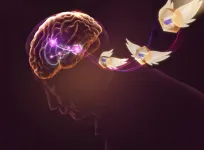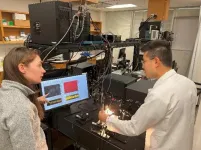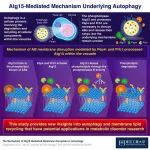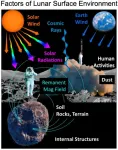(Press-News.org) All-nighters can cause giddy and slap-happy feelings
This effect is caused by increased dopamine release in distributed brain regions
This dopamine signal also enhances plasticity in the neuronal connections, causing a potent antidepressant effect that lasts for days
Study suggests that prefrontal cortex and its dopamine inputs are key for rapid plasticity and antidepressant effects after brief sleep loss
EVANSTON, Ill. — Most people who have pulled an all-nighter are all too familiar with that “tired and wired” feeling. Although the body is physically exhausted, the brain feels slap-happy, loopy and almost giddy.
Now, Northwestern University neurobiologists are the first to uncover what produces this punch-drunk effect. In a new study, researchers induced mild, acute sleep deprivation in mice and then examined their behaviors and brain activity. Not only did dopamine release increase during the acute sleep loss period, synaptic plasticity also was enhanced — literally rewiring the brain to maintain the bubbly mood for the next few days.
These new findings could help researchers better understand how mood states transition naturally. It also could lead to a more complete understanding of how fast-acting antidepressants (like ketamine) work and help researchers identify previously unknown targets for new antidepressant medications.
The research will be published online on Thursday (Nov. 2) in the journal Neuron. Northwestern postdoctoral fellow Mingzheng Wu is the paper’s first author, and Professor Yevgenia Kozorovitskiy is the corresponding author.
“Chronic sleep loss is well studied, and it’s uniformly detrimental effects are widely documented,” Kozorovitskiy said. “But brief sleep loss — like the equivalent of a student pulling an all-nighter before an exam — is less understood. We found that sleep loss induces a potent antidepressant effect and rewires the brain. This is an important reminder of how our casual activities, such as a sleepless night, can fundamentally alter the brain in as little as a few hours.”
An expert in neuroplasticity, Kozorovitskiy is an associate professor of neurobiology and the Irving M. Klotz Professor at Northwestern’s Weinberg College of Arts and Sciences.
Signs of sleep loss
Scientists long have known that acute perturbations in sleep are associated with altered mental states and behaviors. Alterations of sleep and circadian rhythms in patients, for example, can trigger mania or occasionally reverse depressive episodes.
“Interestingly, changes in mood state after acute sleep loss feel so real, even in healthy subjects, as experienced by myself and many others,” Wu said. “But the exact mechanisms in the brain that lead to these effects have remained poorly understood.”
To explore these mechanisms, Kozorovitskiy and her team developed a new experiment to induce acute sleep loss in mice that did not have genetic predispositions related to human mood disorders. The experimental setup needed to be gentle enough to avoid causing substantial stress for the animals but just uncomfortable enough to prevent the animals from falling asleep. After a sleepless night, the animals’ behavior shifted to become more aggressive, hyperactive and hypersexual, compared to controls that experienced a typical night’s sleep.
Using optical and genetically encoded tools, the researchers measured the activity of dopamine neurons, which are responsible for the brain’s reward response. And they found activity was higher in animals during the brief sleep loss period.
“We were curious which specific regions of the brain were responsible for the behavioral changes,” Kozorovitskiy said. “We wanted to know if it was a large, broadcast signal that affected the entire brain or if it was something more specialized.”
Specialized signal
Kozorovitskiy and her team examined four regions of the brain responsible for dopamine release: the prefrontal cortex, nucleus accumbens, hypothalamus and dorsal striatum. After monitoring these areas for dopamine release following acute sleep loss, the researchers discovered that three of the four areas (the prefrontal cortex, nucleus accumbens and hypothalamus) were involved.
But the team wanted to narrow down the results even further, so they systematically silenced the dopamine reactions. The antidepressant effect disappeared only when researchers silenced the dopamine response in the medial prefrontal cortex. By contrast, the nucleus accumbens and hypothalamus appeared to be most involved in the hyperactivity behaviors but were less connected to the antidepressant effect.
“The antidepressant effect persisted except when we silenced dopamine inputs in the prefrontal cortex,” Kozorovitskiy said. “That means the prefrontal cortex is a clinically relevant area when searching for therapeutic targets. But it also reinforces the idea that has been building in the field recently: Dopamine neurons play very important but very different roles in the brain. They are not just this monolithic population that simply predicts rewards.”
Heightened neuroplasticity
While most of the behaviors (such as hyperactivity and increased sexuality) disappeared within a few hours following acute sleep loss, the antidepressant effect lingered for a few days. This suggested that synaptic plasticity in the prefrontal cortex might be enhanced.
When Kozorovitskiy and her team examined individual neurons, they discovered just that. The neurons in the prefrontal cortex formed tiny protrusions called dendritic spines, highly plastic features that change in response to brain activity. When the researchers used a genetically encoded tool to disassemble the synapses, it reversed the antidepressant effect.
Evolving to avoid predators?
While researchers do not fully understand why sleep loss causes this effect in the brain, Kozorovitskiy suspects evolution is at play.
“It’s clear that acute sleep deprivation is somehow activating to an organism,” Kozorovitskiy said. “You can imagine certain situations where there is a predator or some sort of danger where you need a combination of relatively high function with an ability to delay sleep. I think this could be something that we’re seeing here. If you are losing sleep routinely, then different chronic effects set in that will be uniformly detrimental. But in a transient way, you can imagine situations where it’s beneficial to be intensely alert for a period of time.”
Kozorovitskiy also cautions people not to start pulling all-nighters in order to brighten a blue mood.
“The antidepressant effect is transient, and we know the importance of a good night’s sleep,” she said. “I would say you are better off hitting the gym or going for a nice walk. This new knowledge is more important when it comes to matching a person with the right antidepressant.”
The study, “Dopamine pathways mediating affective state transitions after sleep loss,” was supported by the One Mind Nick LeDeit Rising Star Research Award, the BD2: Breakthrough Disocoveries for Thriving with Bipolar Disorder (Discovery Award), the National Institutes of Health (grant numbers R01NS107539 and R01MH117111) and the Rita Allen Foundation Scholar Award. Some of the co-authors were supported by fellowship awards, including the Christina Enroth-Cugell and David Cugell Fellowship, the American Heart Association and NIH training programs (award numbers T32AG20506 and 2T32GM15538).
END
One sleepless night can rapidly reverse depression for several days
Acute sleep loss increases dopamine release and rewires the brain, new study finds
2023-11-02
ELSE PRESS RELEASES FROM THIS DATE:
Circuit-specific gene therapy brings new hope for treatment of Parkinson’s disease
2023-11-02
Researchers from the Shenzhen Institute of Advanced Technology (SIAT) of the Chinese Academy of Sciences (CAS) and their collaborators have developed a gene therapy strategy to selectively manipulate Parkinson's disease-affected circuitry and attenuate the core motor symptoms of Parkinson's disease in rodent and nonhuman primate animals.
The study was published in Cell on Nov. 2.
Parkinson's disease, characterized by the loss of midbrain dopaminergic neurons, is one of the most common neurodegenerative diseases in the elderly population, affecting more than 6 million people worldwide.
Dopamine ...
Higher risk of breast cancer in women with false positive mammography result
2023-11-02
Women who receive a false positive mammography result are more likely to develop breast cancer over the subsequent 20 years, report researchers from Karolinska Institutet in a study published in JAMA Oncology. The risk is highest for women aged between 60 and 75 and who have low breast density.
In global terms, breast cancer is the most common form of cancer among women, and screening is an important tool for catching women with a tumour at the earliest possible stage. In Sweden, all women between ...
PTSD symptoms and cardiovascular and brain health in women
2023-11-02
About The Study: In this study of 274 midlife women, greater posttraumatic stress disorder (PTSD) symptoms were associated with higher carotid atherosclerosis and, among women who were APOEɛ4 carriers, greater brain small vessel disease and poorer cognitive performance. These findings point to the adverse implications of PTSD symptoms for cardiovascular and neurocognitive health among women in midlife, particularly for women who are APOEɛ4 carriers.
Authors: Rebecca C. Thurston, Ph.D., of the University of Pittsburgh, is the corresponding author.
To access the embargoed ...
Breast cancer incidence after a false-positive mammography result
2023-11-02
About The Study: The findings of this study suggest that the risk of developing breast cancer after a false-positive mammography result differs by individual characteristics and follow-up. These findings can be used to develop individualized risk-based breast cancer screening after a false-positive result.
Authors: Xinhe Mao, M.Sc., of the Karolinska Institutet in Stockholm, is the corresponding author.
To access the embargoed study: Visit our For The Media website at this link https://media.jamanetwork.com/
(doi:10.1001/jamaoncol.2023.4519)
Editor’s Note: Please ...
Practicing mindfulness can help people make heart-healthy eating choices
2023-11-02
PROVIDENCE, R.I. [Brown University] — Practicing mindfulness focused on healthy eating can be good for the heart, a new study shows, because it improves self-awareness and helps people stick to a heart-healthy diet.
When people who had elevated blood pressure participated in an eight-week mindfulness-based blood pressure reduction program for the study, they significantly improved their scores on measures of self-awareness and adherence to a heart-healthy diet compared to a control group. The results were published in JAMA Network Open.
“Participants ...
Infirmary Health partners with Ochsner Accountable Care Network to improve health outcomes for seniors across the Gulf Coast
2023-11-02
NEW ORLEANS, LA- Ochsner Health, the leading healthcare system in the Gulf South, and Infirmary Health, Alabama's largest private non-profit healthcare provider, are proud to announce a landmark partnership with Ochsner Accountable Care Network, a top-performing accountable care organization (ACO) in both clinical performance and healthcare savings for the Medicare population. The partnership aims to improve health outcomes for seniors across the Gulf Coast region.
Infirmary Health's hospitals and acute care facilities are recognized as national leaders in innovative and compassionate care for ...
Imaging advance poised to provide new insights into reproduction and infertility
2023-11-02
WASHINGTON — Researchers have developed a new optical coherence tomography (OCT) approach that can directly image coordination of tiny hair-like structures known as motile cilia in their natural environment. The ability to observe cilia dynamics in living organisms gives researchers a powerful new tool to investigate how these structures move cells and substances through the female reproductive system, as well as other functions of cilia throughout the body.
“Our new method has the potential to answer the longstanding question about cilia's ...
New study sheds light on the molecular mechanisms underlying lipid recycling within cells
2023-11-02
Recycling is just as essential in cells as in our more familiar macroscopic world. Cells continuously generate waste products and accumulate damaged components while performing regular functions. Various recycling mechanisms have evolved to ensure efficient use of these resources and help maintain homeostasis, with autophagy being one of the most well-preserved among countless animal, plant, and fungal lineages.
In the main form of autophagy, materials floating in the cell are transported to specialized organelles, such as lysosomes or vacuoles, within small capsule-like structures called ...
Researchers identify the mutations that drive resistance to PI3K inhibitors in breast cancer that can be overcome by next generation agents
2023-11-02
Mutations in the PIK3CA gene that lead to elevated production of the PI3Ka protein are among the most frequent alterations found in cancer, including in approximately 40% of hormone receptor–positive breast cancers.
Alpelisib, the first drug targeting PI3Ka, was approved for use in the United States four years ago, but cancers with mutated PIK3CA eventually develop resistance to the medication.
A team led by investigators at the Mass General Cancer Center, a member of the Mass General Brigham healthcare system, recently identified that resistance in some cases can be caused by secondary mutations in the PIK3CA gene itself. This leads ...
Scientists discussed the key questions of solar wind–moon interaction
2023-11-02
As the nearest celestial body to Earth, Moon’s space environment is distinctive to Earth’s mainly because of lack of a significant atmosphere/ionosphere and a global magnetic field. From a global perspective, solar wind can bombard its surface, and the solar wind materials cumulated in the soil record the evolution of the Solar System. Many small-scale remanent magnetic fields are scattered over the lunar surface and, just as planetary magnetic fields protect planets, they are believed to divert the incident solar wind and shield the local lunar surface beneath, thus producing ...
LAST 30 PRESS RELEASES:
First Editorial of 2026: Resisting AI slop
Joint ground- and space-based observations reveal Saturn-mass rogue planet
Inheritable genetic variant offers protection against blood cancer risk and progression
Pigs settled Pacific islands alongside early human voyagers
A Coral reef’s daily pulse reshapes microbes in surrounding waters
EAST Tokamak experiments exceed plasma density limit, offering new approach to fusion ignition
Groundbreaking discovery reveals Africa’s oldest cremation pyre and complex ritual practices
First breathing ‘lung-on-chip’ developed using genetically identical cells
How people moved pigs across the Pacific
Interaction of climate change and human activity and its impact on plant diversity in Qinghai-Tibet plateau
From addressing uncertainty to national strategy: an interpretation of Professor Lim Siong Guan’s views
Clinical trials on AI language model use in digestive healthcare
Scientists improve robotic visual–inertial trajectory localization accuracy using cross-modal interaction and selection techniques
Correlation between cancer cachexia and immune-related adverse events in HCC
Human adipose tissue: a new source for functional organoids
Metro lines double as freight highways during off-peak hours, Beijing study shows
Biomedical functions and applications of nanomaterials in tumor diagnosis and treatment: perspectives from ophthalmic oncology
3D imaging unveils how passivation improves perovskite solar cell performance
Enriching framework Al sites in 8-membered rings of Cu-SSZ-39 zeolite to enhance low-temperature ammonia selective catalytic reduction performance
AI-powered RNA drug development: a new frontier in therapeutics
Decoupling the HOR enhancement on PtRu: Dynamically matching interfacial water to reaction coordinates
Sulfur isn’t poisonous when it synergistically acts with phosphine in olefins hydroformylation
URI researchers uncover molecular mechanisms behind speciation in corals
Chitin based carbon aerogel offers a cleaner way to store thermal energy
Tracing hidden sources of nitrate pollution in rapidly changing rural urban landscapes
Viruses on plastic pollution may quietly accelerate the spread of antibiotic resistance
Three UH Rainbow Babies & Children’s faculty elected to prestigious American Pediatric Society
Tunnel resilience models unveiled to aid post-earthquake recovery
Satellite communication systems: the future of 5G/6G connectivity
Space computing power networks: a new frontier for satellite technologies
[Press-News.org] One sleepless night can rapidly reverse depression for several daysAcute sleep loss increases dopamine release and rewires the brain, new study finds





